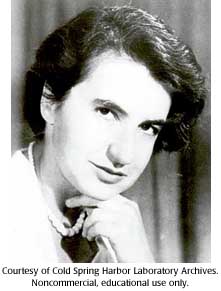Concept 19 The DNA molecule is shaped like a twisted ladder.



 James Watson and Francis Crick solved the structure of DNA. Other scientists, like Rosalind Franklin and Maurice Wilkins, also contributed to this discovery.
James Watson and Francis Crick solved the structure of DNA. Other scientists, like Rosalind Franklin and Maurice Wilkins, also contributed to this discovery.
Rosalind Franklin (1920-1958)

Rosalind Elsie Franklin was born in London, England. Her family was well-to-do and both sides were very involved in social and public works. Franklin's father wanted to be a scientist, but World War I cut short his education and he became a college teacher instead. Rosalind Franklin was extremely intelligent and she knew by the age of 15 that she wanted to be a scientist. Her father actively discouraged her interest since it was very difficult for women to have such a career. However, with her excellent education from St. Paul's Girls' School ? one of the few institutions at the time that taught physics and chemistry to girls ? Franklin entered Cambridge University in 1938 to study chemistry.
When she graduated, Franklin was awarded a research scholarship to do graduate work. She spent a year in R.G.W. Norrish's lab without great success. Norrish recognized Franklin's potential but he was not very encouraging or supportive toward his female student. When offered the position as an assistant research officer at the British Coal Utilization Research Association (CURA), Franklin gave up her fellowship and took the job.
CURA was a young organization and there was less formality on the way research had to be done. Franklin worked fairly independently, a situation that suited her. Franklin worked for CURA until 1947 and published a number of papers on the physical structure of coal.
Franklin's next career move took her to Paris. An old friend introduced her to Marcel Mathieu who directed most of the research in France. He was impressed with Franklin's work and offered her a job as a "chercheur" in the Laboratoire Central des Services Chimiques de l'Etat. Here she learned X-ray diffraction techniques from Jacques Mering.
In 1951, Franklin was offered a 3-year research scholarship at King's College in London. With her knowledge, Franklin was to set up and improve the X-ray crystallography unit at King's College. Maurice Wilkins was already using X-ray crystallography to try to solve the DNA problem at King's College. Franklin arrived while Wilkins was away and on his return, Wilkins assumed that she was hired to be his assistant. It was a bad start to a relationship that never got any better.
Working with a student, Raymond Gosling, Franklin was able to get two sets of high-resolution photos of crystallized DNA fibers. She used two different fibers of DNA, one more highly hydrated than the other. From this she deduced the basic dimensions of DNA strands, and that the phosphates were on the outside of what was probably a helical structure.
She presented her data at a lecture in King's College at which James Watson was in attendance. In his book The Double Helix, Watson admitted to not paying attention at Franklin's talk and not being able to fully describe the lecture and the results to Francis Crick. Watson and Crick were at the Cavendish Laboratory and had been working on solving the DNA structure. Franklin did not know Watson and Crick as well as Wilkins did and never truly collaborated with them. It was Wilkins who showed Watson and Crick the X-ray data Franklin obtained. The data confirmed the 3-D structure that Watson and Crick had theorized for DNA. In 1953, both Wilkins and Franklin published papers on their X-ray data in the same Nature issue with Watson and Crick's paper on the structure of DNA.
Franklin left Cambridge in 1953 and went to the Birkbeck lab to work on the structure of tobacco mosaic virus. She published a number of papers on the subject and she actually did a lot of the work while suffering from cancer. She died from cancer in 1958.
In 1962, the Nobel Prize in Physiology or Medicine was awarded to James Watson, Francis Crick, and Maurice Wilkins for solving the structure of DNA. The Nobel committee does not give posthumous prizes.


DNA was first crystallized in the late 70's — remember, the 1953 X-ray data were from DNA fibers. So, the real "proof" for the Watson-Crick model of DNA came in 1982 after the B-form of DNA was crystallized and the X-ray pattern was solved.

If the DNA of one human cell is stretched out, it would be almost 6 feet long and contain over three billion base pairs. How does all this fit into the nucleus of one cell?
 DNA and proteins are key molecules of the cell nucleus.
DNA and proteins are key molecules of the cell nucleus. One gene makes one protein.
One gene makes one protein. A gene is made of DNA.
A gene is made of DNA. Bacteria and viruses have DNA too.
Bacteria and viruses have DNA too. The DNA molecule is shaped like a twisted ladder.
The DNA molecule is shaped like a twisted ladder. A half DNA ladder is a template for copying the whole.
A half DNA ladder is a template for copying the whole. RNA is an intermediary between DNA and protein.
RNA is an intermediary between DNA and protein. DNA words are three letters long.
DNA words are three letters long. A gene is a discrete sequence of DNA nucleotides.
A gene is a discrete sequence of DNA nucleotides. The RNA message is sometimes edited.
The RNA message is sometimes edited. Some viruses store genetic information in RNA.
Some viruses store genetic information in RNA. RNA was the first genetic molecule.
RNA was the first genetic molecule. Mutations are changes in genetic information.
Mutations are changes in genetic information. Some types of mutations are automatically repaired.
Some types of mutations are automatically repaired.